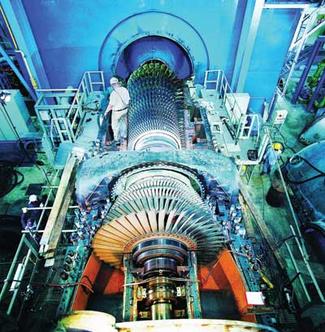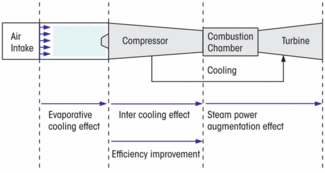|

Home | Products | Customer Reference | News & Activity | Contact Us
September Powering up DEWA’s gas turbines
Moreover, in the Gulf Region these two are intrinsically linked because water is primarily produced by desalination systems, which require a tremendous amount of power to drive distillation or high-pressure membrane installations. Electricity and water’s GDP share in 2007 was AED10.9 billion compared to AED9.5 billion the previous year, a phenomenal growth of 14.7 per cent. The electricity and water sector has consistently experienced double-digit growth every year from 2003, and out-performed the country’s total GDP growth rate to accommodate the construction boom and an ever-expanding population. The supply of electricity and water is controlled by each emirate within the UAE rather than at the federal level. The Dubai Electricity and Water Authority (DEWA), for example, is responsible for providing these utilities in the emirate of Dubai. Dubai’s Challenge and Solution Despite Dubai being hit by the current economic downturn, DEWA still faces one of the highest growth rates in electricity demand in the region, with an annual rise of between 12-14 per cent. In response to this DEWA announced plans to quadruple its power generation capacity to 25 000 MW by 2017. To supplement its planned large-scale power and water projects to boost capacity about 4 GW to 11 GW by 2011, DEWA also set the goal of providing an additional 400 MW of power by upgrading its existing power generating units. DEWA operates a fleet of combustion gas turbines, which have a total capacity of over 2.5 GW. Following a study that reviewed current practices at other power generating plants, DEWA concluded that a power augmentation system that cooled the inlet air temperature of gas turbines offered the best opportunity to increase the capacity of its existing machines. The Inlet Air Cooling Concept In a gas turbine, the air for combustion is drawn from the atmosphere. This air flows into the front end of the machine, where the compressor section is located. The air is then compressed in the compressor, before entering the combustion chamber where it is used in the combustion process, along with the fuel to produce a high temperature/high pressure combustion gas. The generated power is a factor of the difference in air temperature before combustion and after combustion. The hot gas then flows through the turbine section, where its energy is used to rotate the gas turbine shaft that produces electricity in the generator, which is mechanically coupled to the gas turbine. The hot exhaust gases are further routed to heat recovery boilers where their heat is used to produce steam for use in desalination plants for production of distillated water or in steam turbines to generate additional power. Gas turbine capacity reduces when the temperature of the ambient air used as the turbine inlet air increases. The increase in inlet air temperature also results in a reduction in efficiency, i.e. more fuel is needed to produce each unit of electricity. The standard gas turbine ratings are specified at 15 ºC. When the gas turbines are installed in places like Dubai however, where the ambient temperatures in summer reach almost 50 ºC, the drop in gas turbine capabilities is significant. With fuel cost constituting the major cost of operation and maintenance of a gas turbine, the lower efficiency translates into millions of dirhams for a large power station. To counter this undesired effect, there are techniques available that can lower the inlet air temperature In pursuit of using the best available technology for intake air cooling, DEWA initially specified one of the most popular methods, called ‘evaporative cooling’, for its gas turbines at the Jebel Ali power and desalination station D. DEWA also considered ‘fogging’ and ‘refrigerative cooling’. The latter however, was ruled out due to its requirement for land and a high relative capital cost. Subsequently, DEWA became aware of an innovative system, called ‘wet compression’, originally developed by Dow Chemicals and Westinghouse. Wet compression has the benefit compared to either fogging or evaporative cooling of providing a steady increase in the gas turbine power and efficiency throughout the day and all-year round irrespective of ambient humidity and temperature. The power boosting capability of the other two options is limited to the dry period of the day and the season. Evaporative cooling and fogging can become ineffective right at the time when they are needed the most, i.e. when relative humidity is high- a fact of life during the hottest seasons in Dubai. Wet Compression Concept In a wet compression system, a controlled volume of demineralized water is sprayed into the bell mouth of the compressor, resulting in an enhancement of the overhaul performance of a gas turbine through three mechanisms: Evaporative cooling of the inlet air stream – cooler air means a reduction in the work required to compress the inlet air, which is translates into higher engine efficiency. Inter-cooling of the compressor – as the air becomes hotter in the front stages of the compressor, water is rapidly evaporated, which effectively cools the air. Again, this leads to a reduction in the amount of work required to compress the working fluid, leaving more power to drive the generator to produce higher electrical power. Increased mass flow through the engine – this is due to the ‘over-spray’ of water into the compressor inlet and to the additional amount of fuel that is used to raise the temperature of the combustion air in order to maintain the turbine design inlet temperature.
However, the water injection can expose compressor vanes and blades to corrosion. Furthermore the aerodynamic loading in the compressor end stages can be above design values, and therefore the final few stages of compressor internals require replacement with specially designed parts. Implementing Turbine Uprating DEWA invited several contractors, who had submitted systems similar to the wet compression system, to present their designs. A DEWA technical team then evaluated the designs and ensured that the concerns over the increased risk of compressor surge and corrosion of compressor blades and vanes had been addressed. DEWA concluded that only the OEM of the gas turbine could successfully address these concerns, which could only be overcome by incorporating major changes in mechanical and control systems design. So DEWA approached Siemens, the manufacturer of many of its gas turbines. Siemens had also acquired Westinghouse in 1998, and with it the wet compression patent rights.
Siemens developed the required design for the V94.2 gas turbines and offered to install it in one of DEWA’s gas turbines. The design included provision of special coating on all compressor blades and vanes to protect them from corrosion during over-spray. Also, to replace the last stages of compressor blades and vanes – stages 13 to 16 – in order to adapt the operating characteristics and stability margin, according to the compressor surge line of these stages to the change of the volume flow caused by the water injection. It also included various other provisions to protect the entry of water into the gas turbine cooling system and various modifications in the design of the control system to control the spray flow, depending on ambient temperature and humidity and to protect the engine from adverse conditions. Following a thorough technical review and risk assessment, DEWA concluded that Siemens had addressed all its technical concerns and the system would be safe to implement. Further, if the implementation of the wet compression system on the first V94.2 gas turbine proved successful, DEWA would look to roll it out to other units. DEWA’s management approved the proposal and the required budget was allocated. The project was planned for the next scheduled gas turbine outage for a normal major inspection, meaning no additional outage was required for the incorporation of wet compression. A project team was established comprising of engineers from the DEWA Mechanical, Electrical and Instrumentation & Control departments, which worked closely with the Siemens engineering and project team during planning of the works prior to gas turbine outage, during the outage and afterwards during commissioning and warrant period. Following the successful implementation of the project and the completion of 2000 hours of operation under Siemens’ guarantee, DEWA’s management approved the incorporation of the wet compression system in three more V94.2 gas turbines, with the potential for seven more units. Benefits of Augmenting Power The benefits of using a wet compression system to augment the power of a gas turbine is manifold. The system can be installed within four weeks during a routine major inspection outage, and multiple units at different stations can be upgraded at the same time. This compares to an erection time of between 1 to 2 years for installing a major power generating plant. A wet compression system also costs a fraction of what it costs for a new power plant. The capital cost for a wet compression upgrade for three units is around AED36 million against AED88 million for a comparable power generating unit. Therefore, the capital saving is in the region of AED52 million for three units, for example. It is also possible to make operational savings. The cost of operating and maintaining a 60 MW power plant, for example, is roughly AED13 million per year, whereas a wet compression system incorporated into three gas turbines will cost a fraction of that at around AED400 000. In 20 years the difference equates to AED252 million for three gas turbines. In a Siemens V94.2 gas turbine, the output power gain from wet compression is approximately 20 MW. Thus, if wet compression is installed in a total of 11 of DEWA’s V94.2 gas turbine it will result in a power increase of 220 MW – making a significant contribution to DEWA’s goal of achieving an additional 400 MW from existing power generating equipment. One of DEWA’s strategic goals is to reduce nitrogen oxides (NOx) emission from its power generating gas turbines. Based on performance tests in one of Siemens’ V94.2 gas turbines, the NOx emissions from the gas turbine incorporating wet compression fell from 42 parts per million (ppm) to 28 ppm. This represents around a 33 per cent reduction in one of the major pollutants of the environment from gas turbines, which in turn are one of the major sources of this pollutant. When the system is implemented on DEWA’s V94.2 gas turbines as planned, there will be a significant improvement in total NOx emission in Dubai. The space required for a 220 MW conventional power station, for example, including gas turbines, generators, auxiliaries, fuel systems, fire fighting systems, control rooms, switch gear rooms, transformers is huge. Whereas the space requirement for a wet compression system is limited to a small skid comprising of couple of pumps and limited piping. Although, additional water treatment and water tanks are required, the space requirement is negligible and can be easily accommodated within the existing equipment or by boosting capacity of present water treatment facilities without the requirement for additional land. The cost saving in respect to both capital depreciation and interest can be more than AED6 million per year, up to AED120 million based on a 20-year design life for three gas turbines. Manpower levels do not need to be increased to cater for the operation of this additional facility, whereas a significant number of operations, maintenance and administrative staff are needed to run a new 220 MW power plant. These result in a significant cost saving over the equipment’s 20-year design life in terms of salaries and overhead cost pertinent to large crews. Finally, a significant cost reduction can be achieved because the inventory cost to support the operation of a wet compression system is negligible compared to cost of holding a large inventory of spare parts for a 220 MW power station. MEE
Middle East Energy http://pepei.pennnet.com/articles/Online_SubCategory.cfm 1/09/2009
|




